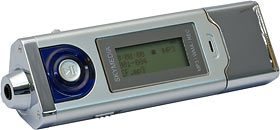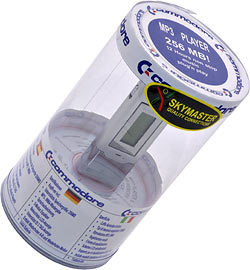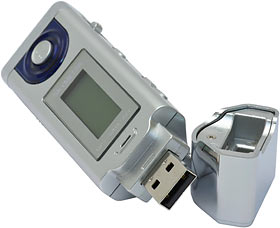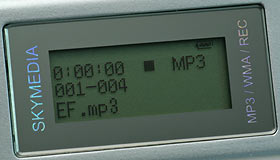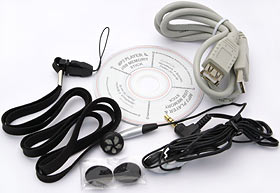
Quick Shot review 13:
Skymedia 256Mb MP3 player
Review date: 17 December 2003.
Last modified
03-Dec-2011.
When I first saw this product, I laughed.
Not because it looks silly. Actually, I think its rounded-Toblerone shape is quite appealing.
Not because it's too expensive. When I first wrote this review Aus PC Market were selling it for $AU199.10 including delivery, which is not bad at all for a 256Mb MP3 player (however, Aus PC Market no longer stock this product).
This is, in fact, a perfectly good little MP3/WMA player. It's another in the line of SigmaTel-powered, (probably) Tai Guen Enterprise-made, well-priced, reasonably easy to use, good looking players, like the ones I've checked out before here and here.
What cracked me up about this one, though, was the packaging.
Aww, yeah.
Old word-I-can't-say-on-a-family-site-ing SCHOOL!
Completely frickin' unlicensed old school, probably, but Commodore Business Machines hasn't existed for some time, now. I doubt anyone's going to get sued for sticking that name and the hallowed C= logo on a plastic tube with an MP3 player inside.
Maybe this player was actually made for someone who bought the Commodore brand fair and square. The software CD it comes with has a German company name and address printed on it; significant portions of the walking corpse that was Commodore dropped off in Germany, so it's plausible that that company could be using the logo legitimately. But I've had no luck digging up any info about them.
(UPDATE: And it now seems quite possible that the name wasn't licensed, since these players are now coming in plain un-branded tubes. Sorry, C= fans!)
Anyway, besides the brand name all over the box, this MP3 player is typically free of identifying marks.
It's got the "Skymedia" brand name printed on it, to go with the "Skymaster" sticker on the packaging. Australian nerds are used to finding various cheap-and-cheerful no-name gear under the Skymaster brand.
But that doesn't mean much. This player is just made on contract like all of the other odd-brand TGE players, and it has no visible model number.
So I'm going to call it "Luke", because turnabout is fair play.
(Originally I called it "Scott", but he was just the editor for that review; Luke wrote it.)
Luke is, in all important respects, a 256Mb "James" player, as reviewed here. It plays MP3 and WMA files, it can record sound in WAV format (with pleasingly clear results from its built-in microphone, in ordinary note-taker situations)...
...it's a plug-and-go USB Mass Storage Device when connected to current Windows systems...
...and it runs from a single AAA cell. Battery included.
The black hole on the near end of the player in this picture is the standard 1/8th inch headphone socket; unlike pretty much every other TGE variant, this one doesn't have its 'phone plug on the side.
This is a good thing for most users. If you shove a side-plugged player into your pocket, you're more likely to damage the headphone cord, especially if you're using headphones with a non-right-angle plug.
The little dot matrix screen is the same, too. This time, laziness compelled me to photograph it when its blue LED backlight was turned off and nothing was scrolling.
As with the other TGE players, you get a decent little bundle with Luke.
One general purpose neck-strappy lanyard. One USB extension lead, so people whose PCs don't have front USB ports won't have to grovel around behind the computer to plug the player in. One pair of UltraCheap™ ear-bud headphones with optional foam pads, blessedly free of a gimmicky FM radio (unlike some I've seen).
The bundled 'phones are better than, say, sticking your tongue into the 1/8th inch socket and trying to interpret the tingling sensations. But I strongly suggest you drop a few bucks on something better.
You also get a mini-CD (the tube the player comes in is just big enough for a 77mm CD), whose contents you should not disregard. If you unplug one of these players during a write operation, or some less likely flash-RAM-scrambling event occurs, you'll need to recover and reformat them with a special utility. I talk about disaster recovery in my original review, here.
You needn't fret about this, as many people never manage to corrupt their TGE player's memory. Just remember that the utility disc does actually have some value. It doesn't just contain some crusty Win98 driver that you'll never need.
So, what's wrong with it?
Well, again like the other TGE players (and various others), Luke doesn't give you quite as much capacity as its label suggests. "256Mb" on the sticker; something like 246Mb actual formatted capacity.
This player's user interface is also, once again, not a masterpiece. Luke comes with late-model firmware and should be pretty much bugless, but the interface still works in much the same way as all of these players back to George and before. It takes a moment to respond to input, it doesn't have play-resume (so it's not much good for listening to audio books), and it generally ain't an iPod sort of experience.
Which raises a question.
Despite the steadily falling price of flash RAM based players like this one, the iPod and the other small hard disk players that languish in its shade are a better deal for many people.
On a dollars-per-megabyte basis, the 10Gb iPod, at $AU529 (don't expect a discount...) absolutely creams every flash RAM player. It costs about one-fourteenth as many dollars per megabyte as poor little Luke.
And the 20 and 40Gb iPods are even better value. Provided you can use need that much space, of course. Plus, there's that better interface. Which the iPod and its ilk must have, of course; you can deal with mildly clumsy controls if you've got 50 songs on a player, but not if you've got several thousand.
If all you want is two-hundred-and-something megabytes of storage, though, why pay more?
Luke's a lot smaller than an iPod, too, and will run for well over ten straight hours from one AAA alkaline cell. If you want more play time, it ain't hard to tote another couple of AAAs around with you.
Flash RAM players like Luke are also even more shock-proof than an iPod, though iPods are pretty darn tough already.
Like an iPod, Luke is also useful as a file storage and transfer device, and you can mix files with music as you like. But Luke, like the other TGE players, works without drivers on any USB-equipped PC running Windows ME, 2000 or XP - and probably with current Macs and Linux systems as well, though the Mass Storage Class drivers on different platforms aren't completely uniform.
Luke is still only a USB 1.1 device, much slower than the FireWire that the iPod uses, and FireWire has been a fairly standard feature on PC motherboards for a little while now. But there are still plenty of machines out there that don't have it. If you're sitting in front of a computer that only has USB ports, then half-megabyte-per-second USB 1.1 is likely to look pretty attractive compared with a trip to the computer store to buy an IEEE 1394 card.
Oh, and the TGE players play WMA files, and can record speech, too. You can do all sorts of fancy things with an iPod if you buy extra bits for it, but nothing will turn it into a high capacity note-taker the size of a cigarette lighter.
Overall
As you may have gathered, I quite like the TGE players. They're good products at a good price. They're not The One MP3 Player That'll Suit Everyone, but they do what most people want a portable player to do, pretty simply and quite stylishly.
At a hair under $AU200 delivered, it's hard not to like this little thing.
And I'm not just saying that because of Amiga nostalgia.
Buy stuff!
Aus PC Market don't sell
this player any more.
Click
here to see their current MP3 players!
